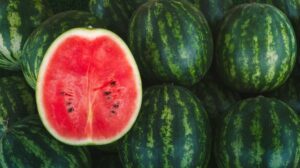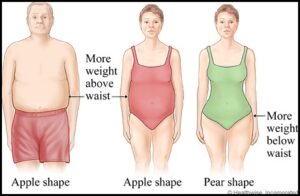This blog will discuss the ways in which a high intake of fructose can increase the risk of cardiovascular disease (a disease involving blood vessels and the heart). Fructose may cause heart disease by altering our lipid profile, raising blood pressure, and causing the body to store more fat in the abdominal area. Excessive fructose intake also causes obesity, but this may be because we are consuming too many calories overall, not just fructose. Most people are aware that added sugar causes diabetes and weight gain but are not aware of the link between sugar intake and heart disease.
Our main sources of added sugar are glucose and fructose. Glucose and fructose are like a double whammy. Glucose raises blood sugar and causes overproduction of insulin (leading to diabetes), while fructose has no effect on glucose but is stored as fat and causes an alteration in lipid profiles. To make matters worse, most foods eaten are a combination of glucose and fructose. When you eat one, you are usually eating the other, at least as added sugar. Before I get into the studies on this topic, I will first explain what sugar is.
What is sugar?
Sugar is the most basic unit of carbohydrates. When you eat any carbohydrate, it ultimately breaks down in the body into monosaccharides (simple sugars). If you keep a cracker in your mouth, it will eventually taste sweet as enzymes in our mouth begin to break down the carbohydrates into simple sugars. Below is a chart about the different types of sugar.
Remember, mono = one and di = two.

High-fructose corn syrup is made by heating up corn starch, which converts some of the glucose molecules into fructose molecules, resulting in a sweeter substance. It is often used because it is cheaper to use corn than sugar cane (sucrose) and because it is so sweet. (1).
Although fruit contains high amounts of fructose, most of the fructose consumed in the United States is from sucrose (which is 50% fructose and 50% glucose), along with high fructose corn syrup (which is 42–55% fructose and the rest glucose). Obviously, this presents a problem, as it is difficult to separate glucose intake from fructose intake, as the two main sources of fructose intake are also 50% glucose.
Average intake of high fructose corn syrup/soda/fructose per day per person
- Median-when you arrange a set of numbers from least to greatest, the median is the number that falls in the middle. (Example-20 22 25 29 33- the median is 25). The median is used along with the average to describe sets of data.
According to the NHANES (National Health and Nutrition Examination Survey), the median fructose intake from added sugar per person in the United States is 74 grams per day, the amount in 2.5 sodas. The average daily intake of fructose is 49 grams, which equals 196 kcal of fructose per day. The Continuing Survey of Food Intake found that people ranked in the top 1/3rd of fructose consumers eat, on average, 137 grams of added sugar per day (548 kcal, 25% of the energy intake of a 2200 kcal diet), and those in the top 10% of sugar consumers eat 178 grams of sugar per day, half of that coming from fructose. That is a seriously high intake of added sugar—712 kcal of sugar per day, to be exact.
Our body processes fructose differently than glucose
Although fructose and glucose are both simple sugars, they are metabolized differently in our bodies. For most people, fructose is primarily broken down in the liver in pathways different from those of glucose. Unlike glucose, when fructose is initially broken down, the body does not have to use insulin, nor do our blood glucose levels rise. This is the reason some doctors advise diabetics to eat primarily fructose instead of glucose, since it will not cause a spike in their blood sugar.
Fructose not used as energy is either converted into glucose and lactate and released into the blood stream, stored in the liver as glycogen (our long-term storage of carbohydrates), or stored as triglycerides in the liver (2). While only a small percentage of fructose is converted to triglycerides, this effect is nonetheless thought to lead to some of the metabolic complications associated with a high fructose intake.
In rodents, both a high-sugar and high-fructose diet lead to diabetes, obesity, dyslipidemia, and a decreased sensitivity to insulin (2).
Fructose intake and blood pressure
Not all studies have found a link between fructose intake and hypertension. Often, studies only compare the sugar in soft drinks and relate that to hypertension. This greatly underestimates total sugar intake, as only about 1/3rd of consumed sugar comes from soft drinks, with the rest coming from bakery products, candy, fruit drinks, and desserts (USDA).
One group of researchers looked at dietary data from NHANES (from 2,400 people) and calculated the median intake of fructose from foods high in added sugar and compared this to blood pressure readings in subjects. After accounting for many variables, such as waist circumference, salt intake, potassium intake, etc., researchers found that a fructose intake of 74 grams a day was associated with elevated blood pressure (3).
This intake of 74 grams is quite interesting. Right after reading this study, I went onto another study that said adding 30–60 grams of fructose per day to the diets of free-living individuals did not have an effect on the lipid profile (4). If 74 grams of fructose per day is where metabolic changes begin to occur, we may be in trouble since the median fructose intake in the United States is 74 grams per day, or 2.5 sodas. That really is not that much, especially since most people have replaced soda cans with soda bottles, which obviously contain a lot more sugar. Many people in the United States would be in trouble if 74 grams of fructose really is where metabolic changes start to happen.
Relationship between the different types of lipoproteins and triglycerides
- Lipoprotein- lipoproteins are a package of protein attached to a lipid. Protein is needed to transport the lipids throughout our body because fat does not mix with water and needs the help of the protein to enter certain cells.
- Lipid profile- refers to HDL (high density lipoprotein), LDL (low density lipoprotein), VLDL (very low density lipoprotein) and triglycerides, which are found in our blood.
- HDL- removes cholesterol from the body. You want high HDL levels.
- LDL, VLDL- transports cholesterol and triglycerides to our cells- you want low levels.
The next few sections discuss how fructose negatively affects our lipid profile, so I should talk about the different types of lipids and lipoproteins first. Basically, HDL’s go around our body looking for extra cholesterol and bring it to the liver for removal from our body. LDL’s bring cholesterol to our cells (which is only bad when it is excessive), while VLDL’s bring mostly triglycerides to our cells (which increases the risk of heart disease). The storage form of fat in our bodies is triglycerides, although triglycerides also reside in our blood. You want low blood triglyceride levels since they increase the risk of heart disease.
Fructose and high fructose corn syrup negatively affect our lipid profile
One study investigated the effect that consuming either a fructose or glucose-sweetened beverage daily for 8 weeks had on the lipid profile. After the study, subjects that consumed the fructose-sweetened beverage saw an increase in plasma lipid and lipoprotein (LDL and VLDL) concentrations, while there was no change in the glucose group. Total and LDL cholesterol increased (badly) in the fructose group but not in the glucose group. HDL concentrations remained unchanged in both groups.
Another study had subjects consume 25% of their daily caloric intake as glucose, fructose, or high fructose corn syrup and measured the effect it had on risk factors for cardiovascular disease (5). After the 2-week study, those in the fructose and high fructose groups had significantly higher levels of triglyceride profiles compared to baseline, but the glucose group had no change. All three groups experienced a late-night peak of triglyceride levels that was higher than baseline. Fasting LDL concentrations increased in the fructose and high fructose groups but not in the glucose group.
While this study is interesting, 25% of daily energy intake coming from fructose for a 2200 kcal diet would be 137 grams of fructose per day (550 kcal of fructose per day), and since the median intake in this country is 74 grams per day, 137 grams seems unrealistically high. Even so, a median intake of 74 grams means that many people consume more than 74 grams per day, but the exact figure is unknown, so this study may be applicable to those who consume extremely high amounts of added sugar per day.
Fructose causes an increase in intra-abdominal fat deposits
- Subcutaneous fat- the fat you can pinch with your fingers. Makes up about 90% of our total body fat. Not as dangerous as intra-abdominal fat.
- Intra-abdominal fat- also known as visceral fat. Makes up about 10% of our total body fat. It covers our liver, intestines and other organs. We cannot pinch it with our fingers. High amounts greatly increase disease risk.
It is suspected that fructose can lead to an increased storage of fat in the intra-abdominal region, more so than glucose. A study in which subjects consumed extra calories as either fructose or glucose found that while both groups gained a comparable amount of weight, only the fructose group experienced an increase in fat in the intra-abdominal area (6). Those who consumed glucose gained more subcutaneous fat than the fructose group.
A study spanning 8 weeks had subjects consume their usual diet plus 25% of their daily energy intake as either a glucose-sweetened beverage or a fructose-sweetened beverage (7). While both groups gained similar amounts of weight, those consuming fructose stored more fat in the intra-abdominal adipose tissue, while those in the glucose group stored more fat in the subcutaneous adipose tissue.
This was quite an interesting study. It appears that eating large amounts of glucose causes more weight gain in the less dangerous subcutaneous fat tissue, while eating large amounts of fructose causes more weight gain in the more dangerous intra-abdominal fat area. This is likely related to the different metabolic pathways that each sugar goes through when consumed.
How intra-abdominal fat deposits negatively affect lipid profile
Intra-abdominal fat around the organs is so dangerous because this fat is biologically active. This fat acts like an endocrine organ, releasing hormones and other substances. Since this fat surrounds the liver, the substances released go from the nearby portal vein to the liver. This can have a negative effect on the production of blood lipids (since the liver is responsible for producing cholesterol). Scientists believe this is the reason that high levels of intra-abdominal fat are associated with high levels of total and LDL cholesterol (bad cholesterol) and low levels of HDL (good) cholesterol.
How the lipid profile is related to heart disease
It is well established that having high LDL and triglyceride levels, in addition to having low HDL levels, greatly increases the risk of heart disease. Although we are unsure of how high triglyceride levels cause heart disease, we do know that LDLs deposit cholesterol in our arteries. Cholesterol is a sticky substance that attaches itself to the walls of our arteries. Too much arterial plaque (from various substances, including cholesterol) restricts blood flow in the arteries, which increases the risk of heart attack and stroke (the flow of blood to part of the brain is blocked, similar to a heart attack).
All added sugars have a negative effect on our body
Almost all studies have linked excessive sugar intake, in any form, to the onset of diabetes, insulin resistance, fatty liver disease, and cardiovascular disease. All added sugar has a negative effect on your health, whether it is fructose or glucose. By writing this blog, I am not trying to say that fructose is worse than glucose and you should therefore eat glucose. I advocate keeping the intake of added sugar close to zero calories per day (we are all humans, and some days we will eat more sugar than we would like). Be careful of fruit juices like apple and orange juice. They contain significant amounts of sugar that are no healthier than table sugar.
Discussion
This blog showed that fructose and glucose are metabolized differently in our body and produce different effects. Dietary glucose is a major risk factor for diabetes, while dietary fructose (except when in fruits) causes an increase in blood pressure, the storage of intra-abdominal fat, and negatively affects our lipid profile. Fructose and glucose have no nutrients whatsoever. They are just empty calories that have disastrous effects on our health. This may sound extreme, but treat added sugar like poison instead of food. It does far more harm than good. Until recently, humans rarely had access to foods with such concentrated amounts of sugar.
You may be wondering if eating fruit, which contains varying amounts of fructose, can also lead to negative health effects. The few studies that have examined this have concluded that the fructose bound in fruit is treated differently than refined fructose and is not associated with an increased disease risk. In fact, nearly all studies have found that high intakes of fruits are associated with reduced risks of most diseases, including diabetes.
Some people think that sugar from a fruit is healthier than sugar from a sugar cane. Beverages like orange juice and apple juice contain sugar from oranges and apples, respectively. Once removed from the fruit and super-concentrated, this sugar behaves just like any other added sugar. Fructose in fruit is a necessary evil. We should consume fruit, and unfortunately, fructose comes along with it. But if we could remove the fructose from a fruit before eating it, the fruit would be even healthier.
I will leave you with this to think about. There are 62 grams of fructose in a liter of Coca-Cola. There are 61 grams of fructose in a liter of Dr. Pepper. There are 66 grams of fructose per liter of Minute Maid 100% apple juice. And there are 28 grams of fructose in a liter of orange juice.
Sources
- Ferder, L., Ferder, M. D., & Inserra, F. (2010). The role of high-fructose corn syrup in metabolic syndrome and hypertension. Current hypertension reports, 12(2), 105-112.
- Tappy, L., Lê, K. A., Tran, C., & Paquot, N. (2010). Fructose and metabolic diseases: new findings, new questions. Nutrition, 26(11), 1044-1049.
- Jalal, D. I., Smits, G., Johnson, R. J., & Chonchol, M. (2010). Increased fructose associates with elevated blood pressure. Journal of the American Society of Nephrology, 21(9), 1543-1549.
- Schaefer, E. J., Gleason, J. A., & Dansinger, M. L. (2009). Dietary fructose and glucose differentially affect lipid and glucose homeostasis. The Journal of nutrition, 139(6), 1257S-1262S.
- Stanhope, K. L., Bremer, A. A., Medici, V., Nakajima, K., Ito, Y., Nakano, T., … & Havel, P. J. (2011). Consumption of fructose and high fructose corn syrup increase postprandial triglycerides, LDL-cholesterol, and apolipoprotein-B in young men and women. The Journal of Clinical Endocrinology & Metabolism.
- Stanhope, K. L., & Havel, P. J. (2009). Fructose consumption: considerations for future research on its effects on adipose distribution, lipid metabolism, and insulin sensitivity in humans. The Journal of nutrition, 139(6), 1236S-1241S.
- Stanhope, K. L., Schwarz, J. M., Keim, N. L., Griffen, S. C., Bremer, A. A., Graham, J. L., … & Havel, P. J. (2009). Consuming fructose-sweetened, not glucose-sweetened, beverages increases visceral adiposity and lipids and decreases insulin sensitivity in overweight/obese humans. The Journal of clinical investigation, 119(5), 1322.





One of the biggest causes of illness in Latin America. Is quite common to see an average lunch with a soda (not as big as in the US). Average sugar used in production of a can of soda is about 14-16 tablespoon……quite scary when you see it like that.
Anyway, we must reduce its use……nice post!
Wow, sodas and juices have a lot of grams of fructose. I always knew juices are bad and high on sugar, but you made it clear to understand how even when they put the natural fruit juices into a juice, they become added sugar. Very interesting.